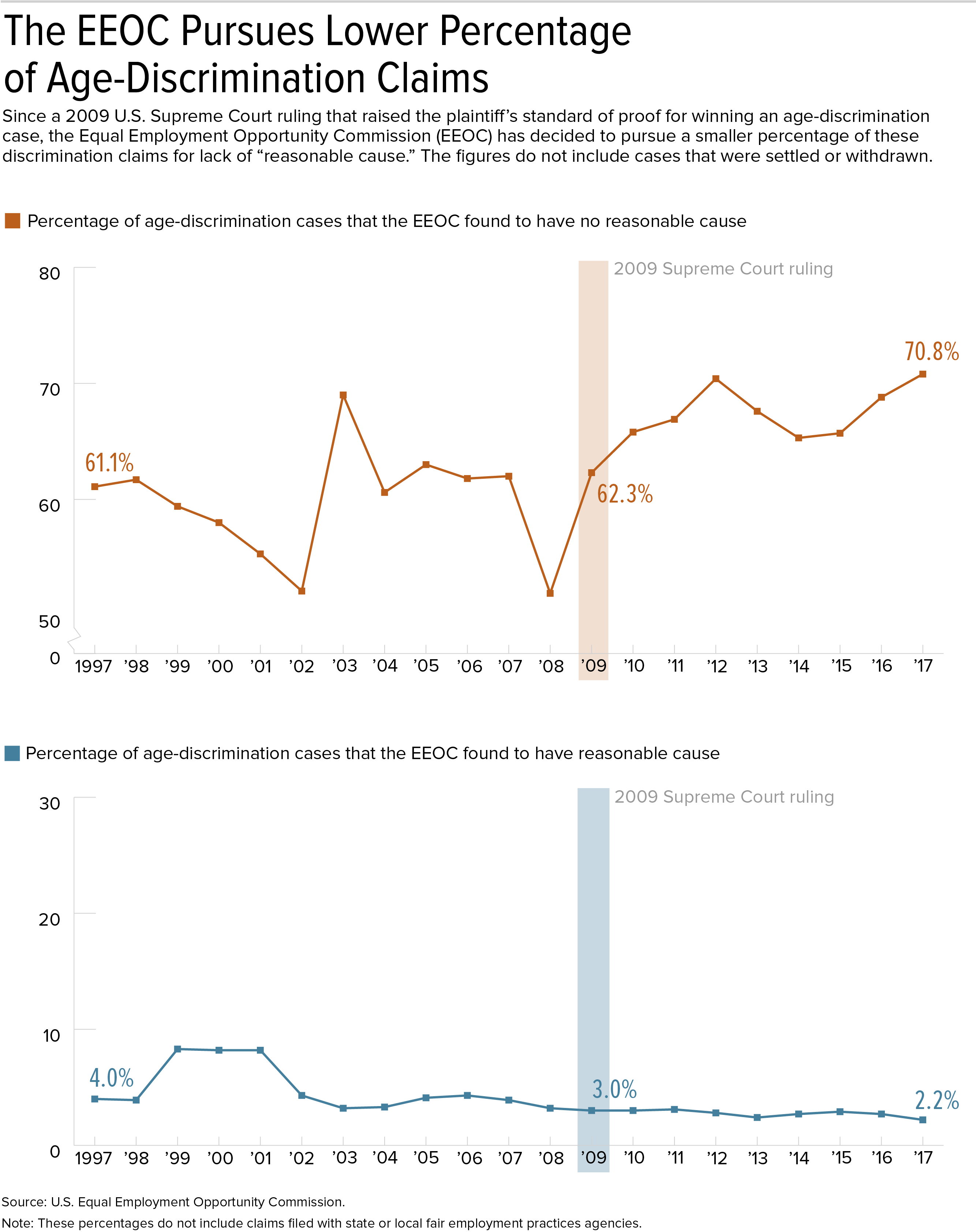50 Years After Age Discrimination Became Illegal, It Persists
In the decade since the Supreme Court made it harder to prove discrimination, EEOC pursues fewer percentages of claims

More than 50 years after Congress made it illegal for employers to discriminate against workers age 40 or older, a new data analysis by the Urban Institute and ProPublica shows that more than half of older U.S. workers are pushed out of longtime jobs before they choose to retire, suffering financial damage that is often irreversible.
ProPublica and the Urban Institute, a Washington think tank, analyzed data from the Health and Retirement Study, the premier source of quantitative information about aging in the United States. Since 1992, the study has followed a nationally representative sample of about 20,000 people from the time they turn 50 through the rest of their lives.
They found that from 1992 to 2016, 56 percent of older workers are either laid off at least once, or leave jobs under such financially damaging circumstances that it's likely they were pushed out rather than left voluntarily.
"Many employers offer incentives to retire early, such as sweetening retirement packages," said Patrick Button, assistant professor of economics at Tulane University and a researcher with the National Bureau of Economic Research Disability Research Center. "But some employers use more sneaky, likely illegal methods to try to encourage older workers to leave, such as job or task reassignment, being [unfairly] negative during performance reviews, not providing workplace accommodations. The goal here is for older workers to quit, which would appear voluntary on the books. But the distinction between voluntary and involuntary job separations is pretty murky, since many 'voluntary' separations aren't necessarily voluntary."
Involuntary job separations can have serious financial consequences. Only 1 in 10 of the workers analyzed in the study went on to earn as much as they did before their employment setbacks.
Supreme Court Ruling Weakened the ADEA
The Age Discrimination in Employment Act (ADEA) of 1967 prohibits employment discrimination against people age 40 or older. But the act was weakened by a 2009 Supreme Court decision. That ruling imposed a much higher burden of proof on workers who allege age discrimination than on those who allege discrimination based on race, religion or gender.
In the 12 years preceding and including the high court's 2009 ruling, Equal Employment Opportunity Commission (EEOC) attorneys found reasonable cause to pursue age-discrimination claims filed with the agency in 4.9 percent of cases on average. This means the EEOC found it likely that age discrimination occurred based on the evidence it acquired during its investigation.
In that same period, the EEOC resolved an average of 18.5 percent of those cases on their merits. This means the EEOC filed charges against companies, with outcomes favorable to the charging parties, or charges with meritorious allegations.
In the eight years following the Supreme Court ruling, EEOC attorneys found reasonable cause to pursue such claims in a lower percentage of cases—3.1 percent on average. During that same period, the EEOC resolved an average of 15.8 percent of those cases on their merits.
Spokespeople for the EEOC could not be reached for comment because of the federal government shutdown.
Few would defend employers who, to achieve cost savings, fire workers who become disabled or pregnant, said Patricia Barnes, an attorney and author of Overcoming Age Discrimination in Employment (self-published, 2016). "However, the U.S. Supreme Court has ruled that it is not age discrimination when employers cut costs by terminating highly paid employees, even if this has an adverse impact on older workers. The key is that the employer must show the decision is truly motivated by the need to achieve cost savings and not based on age discrimination."
[SHRM members-only resource: SHRM Foundation's Effective Practice Guidelines Series, "The Aging Workforce: Leveraging the Talents of Mature Employees"]

Age Discrimination Is Rarely Blatant
In a 2017 AARP survey, a majority of workers ages 45 and older reported that they had seen or experienced age discrimination in the workforce.
Age discrimination can take subtle forms, testified Laurie McCann, a senior attorney with the AARP Litigation Foundation, during a December 2017 U.S. Senate hearing. Few hiring managers would dare say to a job applicant that he or she is "too old" for a position. Instead, McCann testified, companies engage in the following practices:
- Specifying in job postings that the organization seeks "digital natives."
- Recruiting for entry-level positions only on college campuses.
- Requiring a college-affiliated e-mail address to apply to a job opening.
- Using algorithms for online job applications that screen out older applicants.
- Capping the number of years of work experience sought in applicants, such as stipulating that job candidates should have no more than 10 years of experience.
"The overwhelming majority of age-discrimination cases today are based on circumstantial evidence," Barnes said.
Avoiding Age Discrimination
Why employers may be wary of older workers is unclear, the Urban Institute study authors wrote. "They may be concerned about the cost of employing older adults because of perceived high salary demands or heavy use of expensive health benefits, the cost of training older adults who may retire before employers can recoup those investments, or the possibility that older adults may be unfamiliar with the latest technology and lack up-to-date skills."
To avoid the appearance of age discrimination when making employment decisions, Barnes suggested that employers:
- Document the company's goals with respect to any workforce reductions.
- Use objective criteria to make layoff decisions and take care that those criteria don't target older workers disproportionately. For example, an employer shouldn't lay off employees who don't have a specific type of educational degree if that degree wasn't available when older workers graduated from college.
- Avoid comments or actions that reflect negative stereotypes about older workers, such as excluding an older employee from career-advancing projects that require sophistication with computers.
- Conduct a statistical analysis to ensure any workforce reductions don't have a disparate impact on older workers. This is how courts assess whether a pattern of discrimination exists in race- and sex-discrimination cases.
Advertisement
An organization run by AI is not a futuristic concept. Such technology is already a part of many workplaces and will continue to shape the labor market and HR. Here's how employers and employees can successfully manage generative AI and other AI-powered systems.
Advertisement


